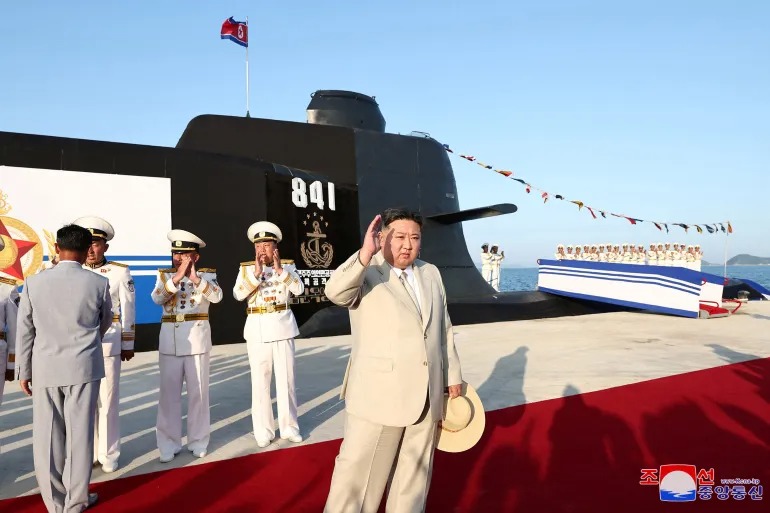In a groundbreaking development that underscores North Korea’s relentless pursuit of military power, the secretive nation has launched its first operational “tactical nuclear attack submarine.” The vessel, named the Hero Kim Kun Ok, represents a significant step in Kim Jong Un’s grand plan to bolster the country’s naval capabilities, including the development of a nuclear-armed fleet. As tensions with the United States and its Asian allies simmer, this audacious move by North Korea holds the potential to reshape the geopolitical dynamics in the region.
Kim Jong Un’s Vision for a Nuclear-Armed Navy
Overseeing the momentous launch, North Korean leader Kim Jong Un emphasized the imperative of rapidly advancing the country’s naval forces. Underlining the importance of “nuclear weaponisation” for the navy, Kim Jong Un expressed his commitment to reinforcing North Korea’s military might. This assertive stance, seen by many as a response to perceived threats from the United States and South Korea, reflects Kim’s determination to consolidate North Korea’s position on the world stage.
The “Hero Kim Kun Ok”: A New Chapter for North Korea’s Navy
Submarine No. 841, affectionately christened the Hero Kim Kun Ok after a prominent historical figure in North Korea, was unveiled in a ceremony overseen by Kim Jong Un himself. According to the official Korean Central News Agency (KCNA), the submarine is specifically designed to launch tactical nuclear weapons from underwater. This milestone, as per KCNA, “heralds the beginning of a new chapter” for North Korea’s naval capabilities. While the exact number of missiles the submarine can carry remains undisclosed, experts speculate that it may have the capacity to deploy up to 10 of North Korea’s Pukgoksong-3 weapons from underwater.
Nevertheless, the operation of such a submarine comes with its own set of challenges, particularly in terms of its propulsion system. Analysts have raised concerns about the submarine’s noise levels, which could make it easier to detect. Additionally, questions persist regarding the accuracy of North Korea’s long-range missile guidance systems, potentially limiting the submarine’s operational range.
The launch ceremony, as depicted in official photos, exuded a festive atmosphere with colorful balloons, confetti, and a jubilant crowd. Kim Jong Un was greeted by hundreds of supporters, dressed in traditional Korean hanbok attire, waving flowers and flags. Sailors stood in unison, applauding as he walked along a red carpet, flanked by senior officers. The Hero Kim Kun Ok, slated to be deployed in the waters between the Korean peninsula and Japan, is poised to become one of the core offensive assets of North Korea’s naval force.
Scepticism and International Concerns Surrounding the Submarine
Despite the grandeur of the launch event, some analysts remain skeptical of the submarine’s actual capabilities. Critics argue that North Korea’s continued militarization has come at the expense of its people, with reports suggesting that resources have been diverted from addressing food shortages to upgrading the country’s armed forces. The United Nations human rights chief, Volker Turk, recently highlighted North Korea’s neglect of its citizens’ basic needs in favor of military ambitions.
Leif-Eric Easley, a professor at Ewha University in Seoul, expressed concerns about the submarine’s viability in combat scenarios. He emphasized that the submarine’s noise levels and perceived lack of security could render it vulnerable, even if its nuclear attack capability is unproven. Easley suggested that North Korea’s allocation of resources towards military expansion might ultimately jeopardize its security.
As North Korea continues to push the boundaries of its military capabilities, the international community watches with growing concern. The launch of the Hero Kim Kun Ok underscores the need for diplomatic efforts to de-escalate tensions and address the broader security issues in the region.
In related developments, a high-level Chinese delegation is scheduled to visit North Korea, coinciding with the country’s 75th founding day celebrations. Meanwhile, North Korean leader Kim Jong Un is expected to travel to Russia, potentially to discuss not only food and energy aid but also advanced weapons technologies, including nuclear-powered submarines, with President Vladimir Putin. These diplomatic maneuvers could have far-reaching implications for the region’s stability.















